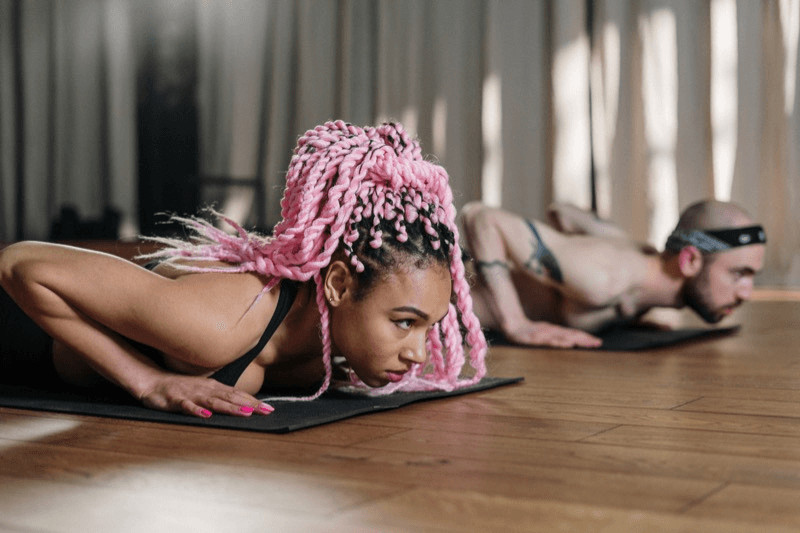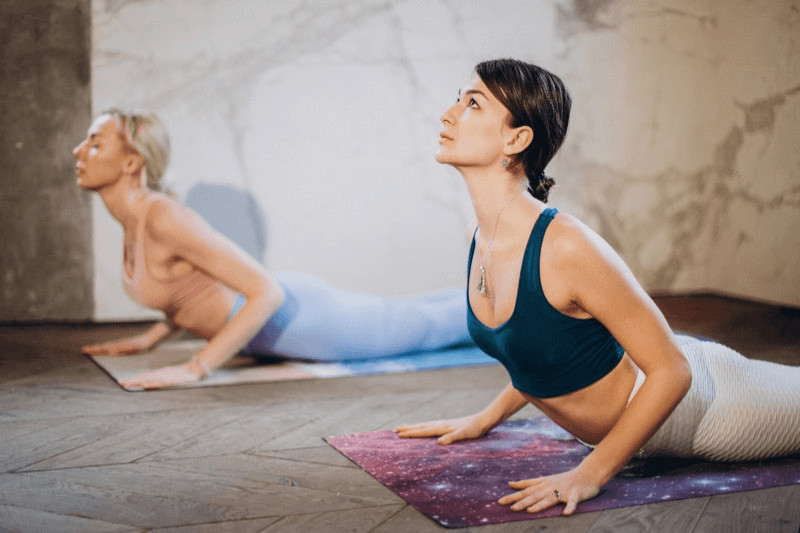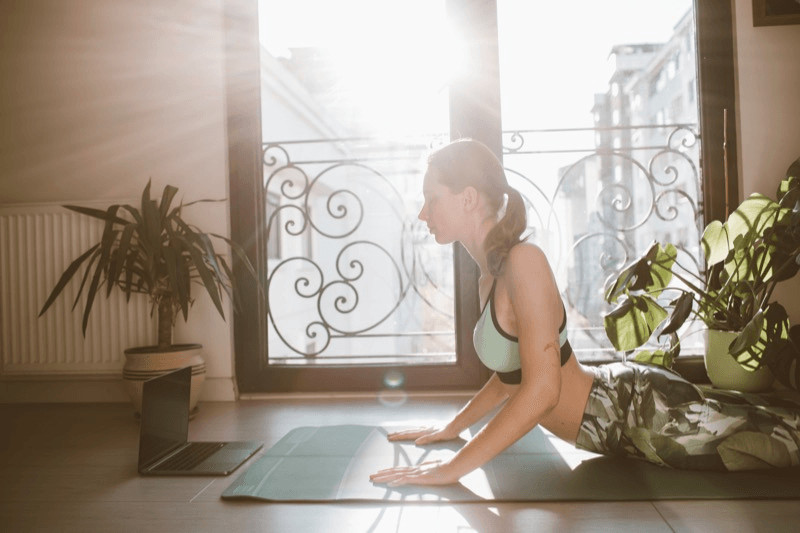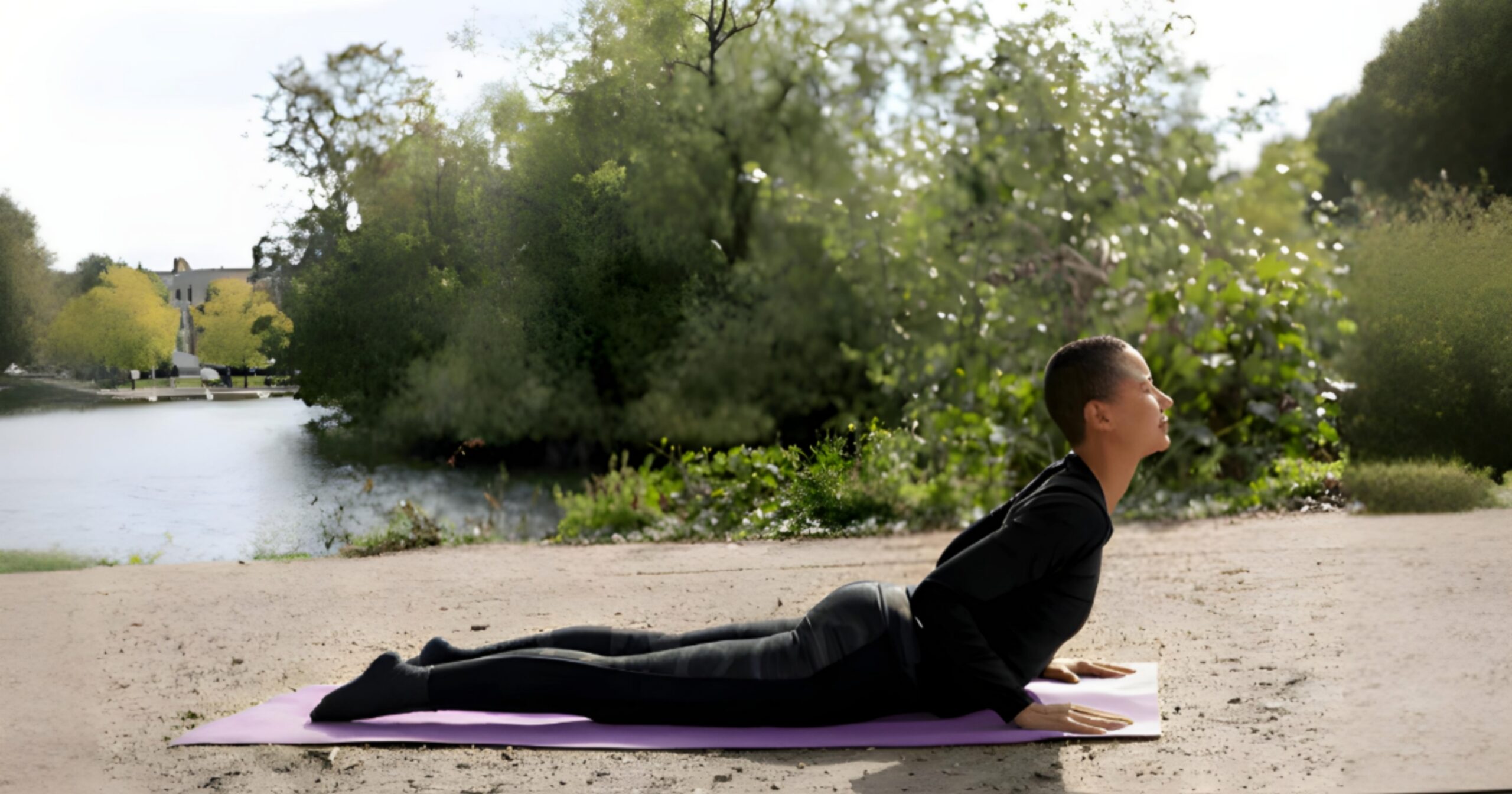Listen to this article:
Key Takeaway
Bhujangasana, or Cobra Pose, is a classic yoga asana that enhances your practice with many health benefits. To safely perform Bhujangasana, follow this step-by-step guide that emphasizes spinal alignment and proper muscle engagement. Pair Bhujangasana with complementary poses while focusing on mindfulness to deepen the experience.
| BHUJANGASANA | |
|---|---|
| Alternate name: | Cobra Pose |
| Difficulty level: | Beginner |
| Pose category: | Backbend |
| Muscle groups: | Erector spinae (back) Trapezius (upper back) Rhomboids (upper back) Latissimus dorsi (mid-back) Gluteus maximus (buttocks) Hamstrings (back of thighs) Triceps (back of arms) Deltoids (shoulders) |
| Physical benefits: | Improves spinal mobility and strengthens back muscles. |
| Therapeutic applications: | Back pain, poor posture |
| Preparatory poses: | Sphinx Pose (Salamba Bhujangasana) Crocodile Pose (Makarasana) |
| Counterposes that follow well: | Child's Pose (Balasana) Rabbit Pose (Sasangasana) |
| Chakras activated: | Swadhisthana Chakra (Sacral Chakra) |
| Most helpful prop: |  Blanket under pelvis; reduces hip bone pressure. See latest price |
Back pain and poor posture are issues many of us who spend a lot of time seated in front of a screen or hunched over a desk. They’re also common problems for which yoga provides relief.
One asana that has been incredibly effective for my back issues is the classic pose, Bhujangasana. This gentle backbend, also called Cobra Pose, has helped me significantly improve my spinal mobility.
As a yoga teacher, I love this asana’s versatility and adaptability. From the subtle nuances of alignment to personalized modifications, Bhujangasana is one of my favorite poses to share with beginners.
Keep reading to join me in exploring the intricacies of this rejuvenating posture. I’ll guide you through each movement step-by-step and offer helpful tips for adding Bhujangasana into your next yoga sequence.
Watch our recommended steps for entering, holding, and exiting the pose.
Contents
- 1 Unveiling Bhujangasana’s Origins and Meaning
- 2 Bhujangasana Step-by-Step Guide
- 3 Modifications and Props for Cobra Pose
- 4 Contraindications and Safety Tips for Bhujangasana
- 5 Incorporating Bhujangasana into Your Yoga Routine
- 6 Complementary Poses to Enhance Bhujangasana
- 7 Positive Health Impacts of Bhujangasana
- 8 Distinguishing Similar Yoga Poses
- 9 Final Remarks
- 10 Frequently Asked Questions
Unveiling Bhujangasana’s Origins and Meaning
Ancient Roots
Bhujangasana, commonly known as Cobra Pose, has deep historical significance in the yoga tradition. This backbend is found in ancient texts like the Gheranda Samhita, revealing its long-standing presence.
Renowned yoga teachers T. Krishnamacharya, K. Pattabhi Jois, and B.K.S. Iyengar popularized this asana throughout the 20th century as part of the Sun Salutation sequence.
Sanskrit Name and Symbolism
The Sanskrit word bhujanga translates to “serpent” or “snake.” The name Bhujangasana reflects the body’s shape in the pose, with an arched back resembling a snake lifting its front half.
The symbolism behind Bhujangasana extends beyond its physical form; it represents rising awareness and shedding old layers like a snake sheds its skin. Understanding these terms can add depth to practicing yoga, encouraging us not just to focus on the asana itself but also on inner transformation.
Bhujangasana Step-by-Step Guide
To ensure you’re doing Bhujangasana correctly, move mindfully and follow each step below.
Initial Position

- Come down to your mat and lie on your stomach.
- Place the tops of your feet on the ground, toes untucked, with your legs separated at a hip-width distance.
- Bring your hands to the ground underneath your shoulders. Keep your elbows close to your sides.
- Place your forehead on the floor so your head and neck are aligned.
- Take a couple of deep breaths to release tension in your back muscles.
Lift into Bhujangasana
- As you inhale, press down through your palms and slowly raise your head and chest off the ground. Keep your pelvis and navel connected to the floor.
- Maintain a gentle upward curve in your spine, reaching the crown of your head forward and up.
- Your elbows should remain slightly bent, pointing straight back rather than splaying out to the sides. Keep pressing your palms down while simultaneously trying to drag them backward to engage your upper arm muscles (triceps).
- Press the tops of your feet into the ground to engage your legs and glutes.
- Broaden your shoulder blades across your upper back, making space between your shoulders and ears.
- Keep your chin level to maintain length in the back of your neck.
- Maintain an even breath pattern while holding Bhujangasana.
- When ready, lower yourself down gently as you exhale. Turn your head to place your cheek on the floor and rest your arms along the sides of your body in Belly Savasana.
Modifications and Props for Cobra Pose
Your level of spinal mobility might make this pose feel challenging. Luckily, there are modifications and variations to help.
Supportive Props
Using props in Cobra Pose can aid in achieving proper alignment and comfort. For example:
- Blanket: A folded blanket under the pelvis adds cushion, especially if you feel pressure on your hip bones against the ground.
- Bolster: If you’re building strength in your back muscles, position a bolster underneath your torso for additional support.
- Block or towel: Position one or two yoga blocks or a rolled towel underneath your forehead to maintain an upward curve in your spine without straining your neck.

lululemon’s Lift and Lengthen Yoga Block
Gentle Variations
For beginners new to Cobra Pose, try a gentle backbend variation first.
- Modified hand position: Plant your hands slightly forward from the shoulders, which allows for a somewhat less intense backbend.
- Crocodile Pose: Lie on your belly and reach your arms forward. Bend your elbows and stack your forearms, resting your forehead on your top arm. This position allows the spine to stretch gently with a subtle upward curve without straining.
Contraindications and Safety Tips for Bhujangasana
Practicing Bhujangasana, or cobra pose, can bring many health benefits. However, as with all backbends, it might not be safe for everyone. Here are some issues to be cautious about.
- Back injuries: Cobra Pose might worsen your pain if you have a herniated disc or other serious spine issues.
- Headache or migraine: While some stretches can help ease the pain of tension headaches and migraines, it’s best to skip Bhujangasana while actively experiencing these conditions. The position can put pressure on cervical nerves and worsen your symptoms.
- Pregnancy: If you’re in your second or third trimester, avoid prone postures like Bhujangasana that put pressure on your abdomen.
Avoiding Overextension
Overextending in Cobra Pose can cause more harm than good. It’s vital not to push too far into the backbend as this can lead to pain.
To prevent overextension:
- Engage your abdominal muscles.
- Maintain an even curve throughout your entire spine.
- Listen to your body and work within your range of motion.
The aim of Bhujangasana is a spinal stretch, not an intense backbend.
Incorporating Bhujangasana into Your Yoga Routine

Sequence Placement and Uses
When using Bhujangasana in a yoga sequence, I find it most beneficial after I warm up with gentle stretches like Cat and Cow or Thread the Needle. Then, I move on to Cobra Pose to prepare for deeper stretches and backbends.
I recommend Bhujangasana as an alternative pose for Upward Facing Dog during Sun Salutations, especially in the first few rounds. Its less intense nature makes it suitable for beginners to build their upper body strength.
Combine With Other Prone Poses
Pairing Cobra Pose with other prone exercises is another effective way to use this pose. After Bhujangasana, try following with poses like Locust or Bow Pose. These sequences engage different back muscles and promote flexibility throughout your spine.
Ready to try Bhujangasana in a sequence? Browse Yogadownload.com’s free classes and start flowing!
Complementary Poses to Enhance Bhujangasana
Create a balanced sequence by including counterposes and poses complementing Bhujangasana’s spinal stretch.
Forward Bends
After practicing Bhujangasana, it’s good to do forward bends. These poses use spinal flexion to help balance the spinal extension of backbends and stretch the back muscles you just strengthened.
Here are my two favorite counterposes after Bhujangasana:
- Child’s Pose: After Cobra Pose, plant your hands on the ground and push your hips back onto your heels. Rest your forehead on the floor and keep your arms reaching forward, or relax them by your sides.
- Rabbit Pose: First, move from Cobra into Child’s Pose. Then, tuck your chin and place the crown of your head on the floor. Reach your arms back and grip your heels. Finally, lift your hips and press them forward to stretch your back muscles.
Spinal Twists
Twists complement spinal extension from Cobra Pose nicely. They offer relief and help maintain flexibility in the spine.
A simple supine spinal twist is a great way to relax your back after Bhujangasana. Lie on your back and bring one knee in toward your chest. Twist as you exhale, taking your bent leg across your body while extending your arm to the side.
Hold your spinal twist for a few breaths, then return to your back and release your leg down. Then, repeat the twist on your other side.
Positive Health Impacts of Bhujangasana
Regularly practicing Bhujangasana brings many health benefits and contributes to both physical and mental well-being.
- Back health: Cobra Pose builds strength in your back muscles and stretches your spine. In my experience, adding this pose to my routine has made my back feel less stiff. I find that it also improves my posture throughout the day.
- Digestive health: Like other backbends, Bhujangasana stretches the abdomen, stimulating digestive organs. This can help with digestion if you’re feeling bloated or sluggish.
- Stress Relief: As a heart opener, Bhujangasana can be a powerful way to relieve stress and fatigue. The pose opens up the chest and shoulders, which promotes deep breathing, calming the mind and reducing stress levels.
- Increased mindfulness: When you take your time entering Cobra Pose, you can feel each vertebra move as you arch your upper body. Bhujangasana heightens body awareness and concentration when you pair movement with breath.
Distinguishing Similar Yoga Poses
If you’re a beginner, it’s easy to confuse Bhujangasana with similar poses. However, each posture has nuances, and it’s essential to recognize their differences.
All of these poses are prone, meaning you begin lying on your stomach. In Cobra Pose, your legs and pelvis remain on the floor. Your palms should be directly underneath your shoulders, and your elbows should be slightly bent.
In contrast, here are the main distinguishing characteristics between these similar prone backbends:
- Upward Facing Dog: In this pose, your palms are directly underneath your shoulders, but the arms are straight. Only the tops of the feet remain on the floor while your legs, pelvis, and navel hover above the ground.
- Seal Pose: I often see students mix up Seal and Cobra Pose. In Seal Pose, your hands should be in front of your shoulders, with your arms straight. Your lower body stays grounded as you lift your upper body into an arch.
- Sphinx Pose: This pose is similar to Bhujangasana, as your legs and pelvis remain on the floor as your chest lifts. The key difference with Sphinx Pose is that you align your elbows under your shoulders rather than your palms, pressing your forearms into your mat.
Knowing the slight differences between these asanas will help you refine your alignment and progress in your practice. To learn more about the nuances of these asanas, read our detailed pose guides for Upward Facing Dog, Seal, and Sphinx!

Final Remarks
Practicing Bhujangasana is as much of an inward journey as it is about mastering the movement. In addition to its physical advantages, Cobra Pose encourages us to cultivate inner strength and resiliency. As you rise and open your heart in Cobra Pose, may you find a renewed sense of vitality and well-being on and off the mat.
From seasoned practitioners to beginner-level yogis, everyone can benefit from incorporating this rejuvenating pose into their yoga practice. Keep exploring, keep breathing, and let the wisdom of Bhujangasana guide you toward greater balance and harmony.
To expand your yoga knowledge and receive great info like this directly in your inbox, join our email newsletter!
Pop quiz! 🧘🤔
The Sanskrit word bhujanga means snake or serpent.
Bhujangasana is a seated pose focused on hip opening.
Bhujangasana is a good warm-up for more intense back-bending poses.
Frequently Asked Questions
What is the origin and meaning of Bhujangasana?
Bhujangasana, or Cobra Pose, originates from the Sanskrit words “bhujanga,” meaning “snake,” and “asana,” meaning “pose.” It symbolizes the rising posture of a serpent.
Can I modify Cobra Pose with props?
Yes, props like a folded blanket under the hips or a bolster under the torso help provide support during Bhujangasana.
How does practicing Bhujangasana benefit health and flexibility?
Bhujangasana strengthens muscles in the back and increases spinal flexibility. It also stimulates abdominal organs, aids in digestion, and encourages mindfulness.
Are there any safety tips for practicing Cobra Pose?
Avoid straining your back by gradually lifting the chest and keeping your elbows slightly bent. Those with back injuries should exercise caution or avoid this pose altogether.







